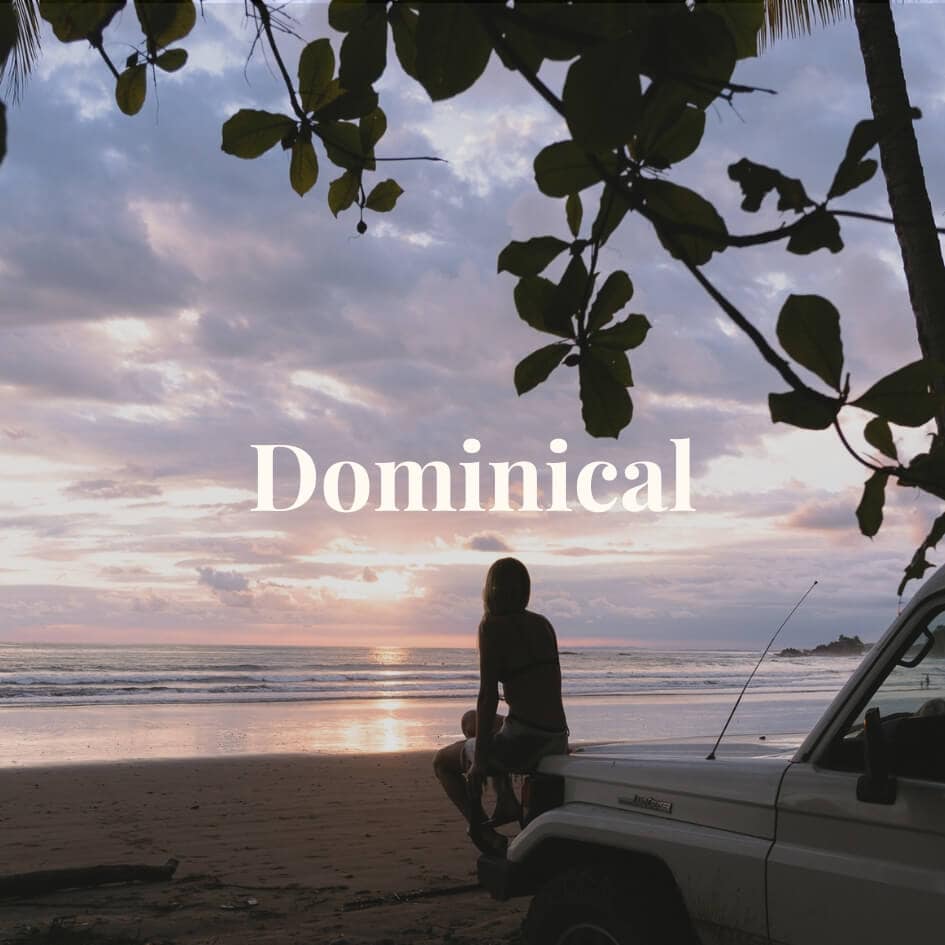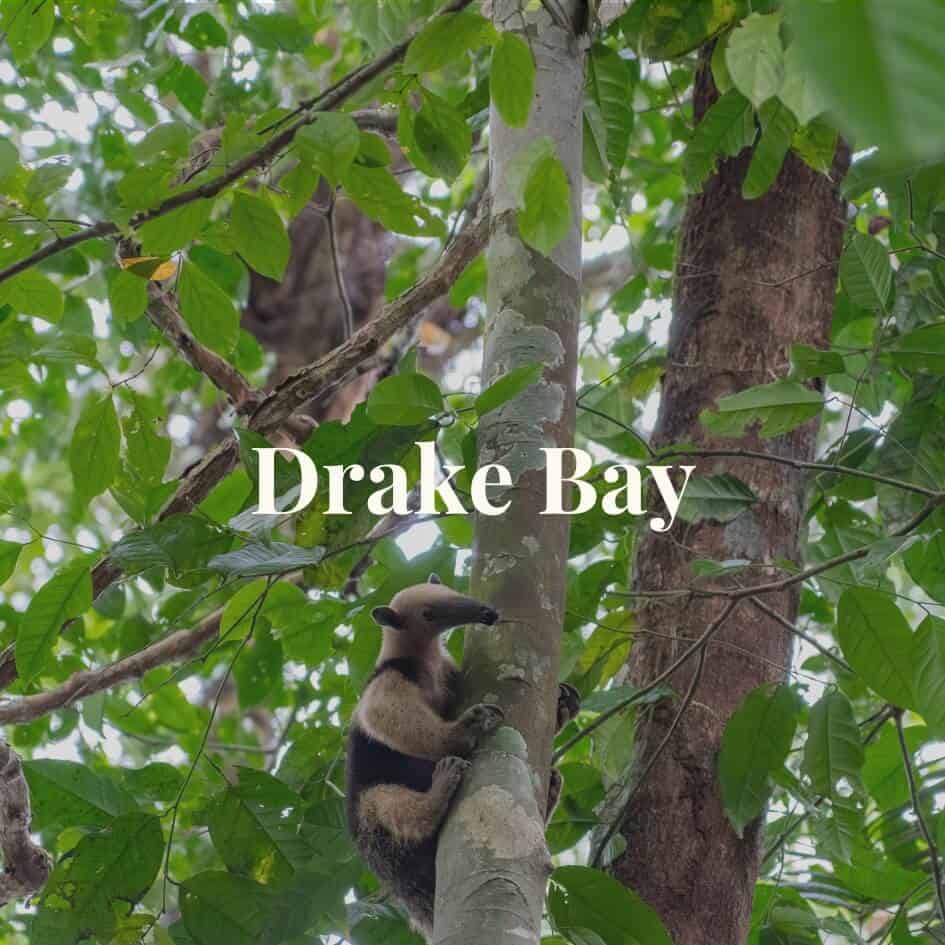In this post, we’ll share the 20 best things to do in Manuel Antonio, Costa Rica, in addition to its famous namesake national park. We’ll also cover travel information like where to stay, how to get there and get around.
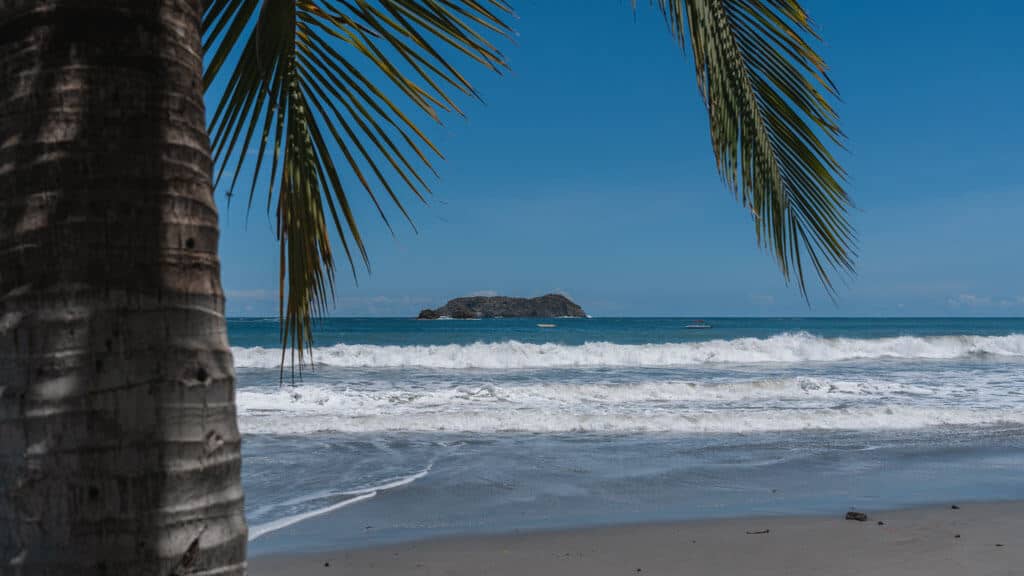
This article may contain affiliate / compensated links, that may earn me a small commission, at no extra cost to you. For full information, please see our disclaimer here. While all efforts have been taken to ensure the information included in this post is correct and current, travel information such as opening hours, business operations and prices change frequently. If you find anything in this post that is incorrect or outdated please let me know in the comments so I can update it for other readers.
Manuel Antonio town, National Park or Quepos?
Before I get into this post, I want to clarify the layout of Manuel Antonio. If you’re a first-time visitor to Manuel Antonio, it can be confusing to understand what this place actually is!
I felt the same, so let’s debunk this.
There are four places/terms you need to be familiar with:
- Manuel Antonio National Park
- Manuel Antonio town
- Quepos
- Route 618
👇🏼 Jump to things to do in Manuel Antonio if you don’t need the extra back info
Manuel Antonio National Park
The area is predominantly known for the Manuel Antonio National Park, one of Costa Rica’s most famous parks. Some travellers purely plan a visit to the national park, and don’t stay or see anything else in the area.
Manuel Antonio town
But what some people don’t know is that Manuel Antonio is actually a small town too. The national park is located in this town.
It’s a very small and spread out village that predominately caters to tourists. It hosts a collection of stunning beaches, tourist accommodations and restaurants tucked into lush rainforest.
The town lacks one central area. There are a couple of ‘mini centres’, but really the entire town is spread along one road, Route 618, between the park entrance and the neighbouring town of Quepos.
Quepos
Just 20 minutes up the road is Quepos. This is the gateway to Manuel Antonio and the national park. To reach the area, you must pass through Quepos first.
It is a larger town and could be considered a ‘regional hub’ for the area. It hosts a large bus station and cruise port. Quepos has a more local feel, and being a larger, functioning town there is a defined centre, with more commercial activity.
Route 618
Route 618 is a steep and narrow road that winds between the hills, connecting Quepos to the entrance of the national park, where the road ends. Most of the town of Manuel Antonio branches off this road.
If you don’t have a rental car, there is a bus that runs frequently (every 20 – 30 minutes) throughout the day along Route 618. It leaves from the bus station in Quepos and turns around at the entrance to the national park, passing through Manuel Antonio town. It is very easy to move along Route 618, and most attractions and accommodations are within a reasonable walking distance of a bus stop.
But a word of warning, you wouldn’t want to walk for long distances on the road as there isn’t a footpath in most places and it’s quite dangerous for pedestrians. Although attractions might not seem far on the map, I wouldn’t plan on walking a long way along the road.
About Manuel Antonio, Costa Rica
Now that we know what Manuel Antonio is, let’s talk about it!
Located on Costa Rica’s Pacific Coast, around 3 hours from San Jose , it’s best known for its famous national park and is one of Costa Rica’s most popular beach towns.
Many people simply visit the national park on a day trip from other areas (San Jose, Jaco, Uvita etc.), and don’t stay or see any of the town or surrounding areas. The national park is incredible, and a must-visit, BUT there is so much more to this town than just the park!
We decided to spend a few nights in Manuel Antonio, and we highly recommend it.
Although the town is a popular fixture on Costa Rica’s tourist trail, its spread-out design means it doesn’t feel too crowded. Eco hostels, boutique hotels and tropical resorts are perched on jungle-clad hills, overlooking the sparkling Pacific Ocean. Wildlife is abundant in and out of the park, and there are a plethora of gorgeous beaches to explore.
Being such a popular place, we were surprised at how much we liked Manuel Antonio! We really enjoyed our time here, and the whole area felt very natural and incredibly scenic.
We watched capuchin monkeys and agoutis playing from the balcony of our accommodation. We sat and ate delicious and cheap casados overlooking the ocean with scarlet macaws flying overhead, and lazed on gorgeous tropical beaches under the shade of the palm trees. And this was before we even visited the incredible national park!
In this post, I want to share some of the best things to do in Manuel Antonio and its surroundings, in addition to the national park.
There are a number of day trips included in this list which may or may not be relevant to you. If you’re moving around a lot in Costa Rica and staying in different places, and plan to head south to Dominical and/or Uvita you can save some of these activities. But if Manuel Antonio is as far south as you’re going, there are some very worthwhile day trips.
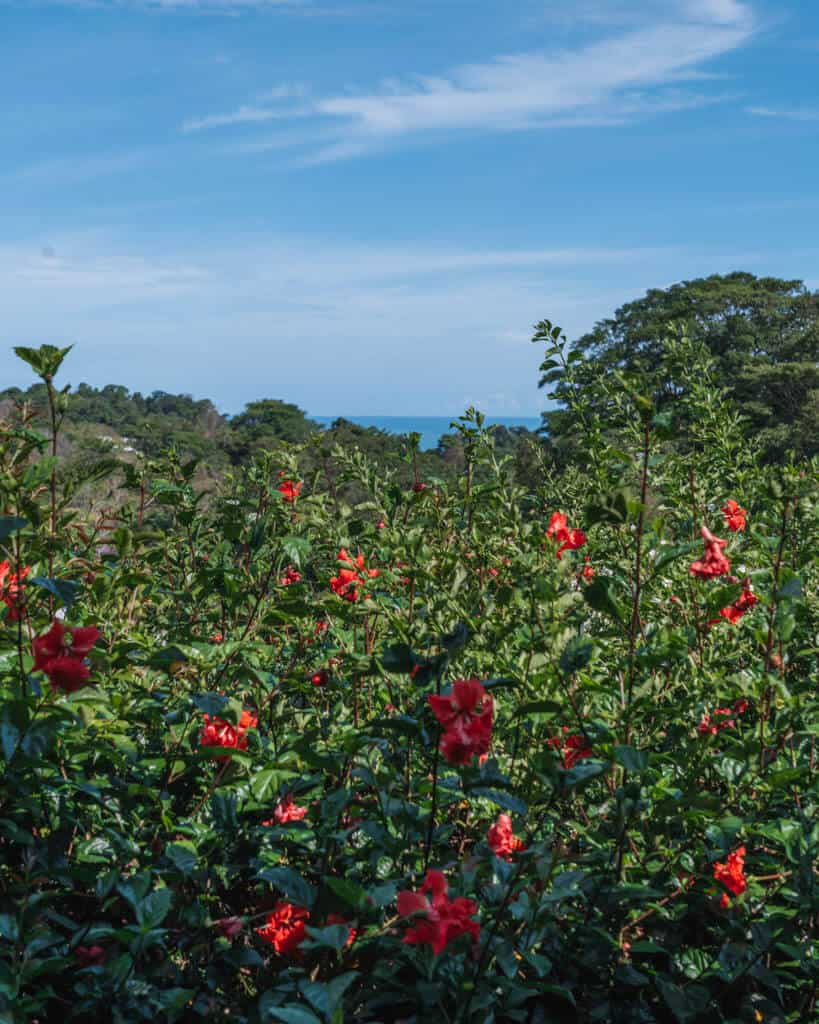
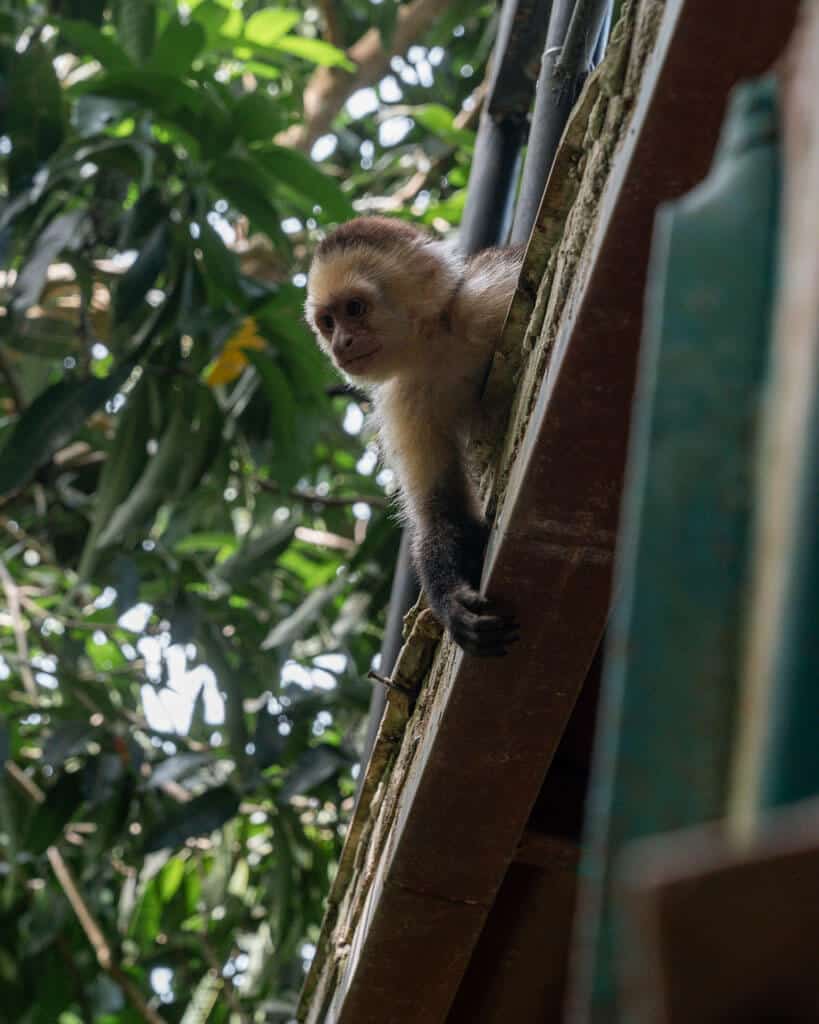
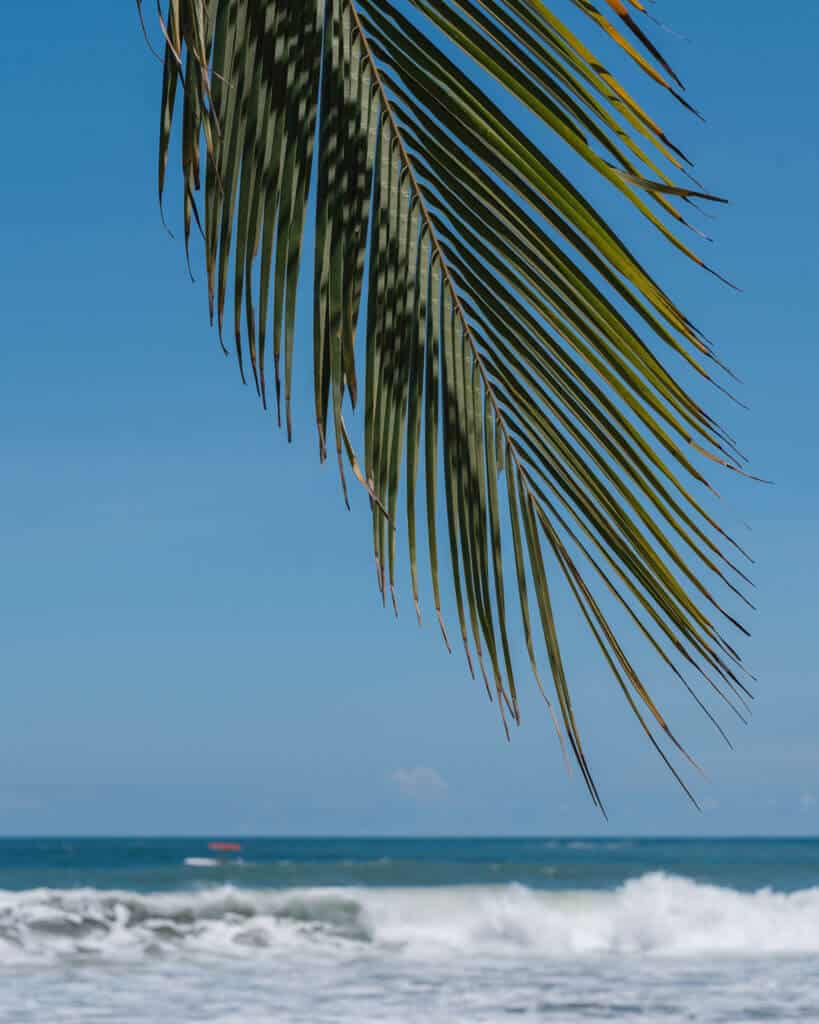
Manuel Antonio quick facts
- 🚙 How to get there – drive your own rental car, bus from San Jose, tourist shuttle from various destinations around Costa Rica
- 🛏️ How long to stay – 2 – 3 nights if you’re also visiting other destinations on the Pacific Coast. Up to a week if you’re choosing Manuel Antonio as a base and doing day trips from there.
- 🗓️ Best time to visit – is during the dry season, which is typically November – April.
Things to do in Manuel Antonio and surrounds
- Things to do in Manuel Antonio
- 🦥 1. Manuel Antonio National Park
- 🐊 2. Visit the Crocodile Bridge in Tarcoles
- 🏝️ 3. Hit the beaches
- ✈️ 4. Eat in a plane at El Avion
- 🍛 5. Try some delicious and affordable Costa Rican cuisine
- 🌞 6. Catch an incredible sunset
- 🏄🏽♀️ 7. Learn to surf
- 🏫 8. Check out the neighbouring town of Quepos
- ⛵️ 9. Cruise around on a catamaran tour
- 🚣🏽♀️ 10. Explore Damas Island on a mangrove tour
- 🐸 11. Discover the jungle after dark on a night tour
- 🦅 12. Fly across the canopy ziplining
- 🦜 13. Support the ethical Kids Saving The Rainforest Wildlife Rescue Centre
- 🍫 14. Join a coffee and chocolate tour
- 🌊 15. Ride the rapids white water rafting
- 💧 16. Visit the Rainmaker Conservation Park
- Day trips from Manuel Antonio
Things to do in Manuel Antonio
The following recommendations are for things to do in Manuel Antonio, that are in the immediate town or less than 1 hour away.
1. Manuel Antonio National Park
Okay, I know this post is sharing the best things do in Manuel Antonio outside of the national park. But it would be remiss of me to not acknowledge the most popular activity in Manuel Antonio!
Most people come to this area purely to visit Manuel Antonio National Park, Costa Rica’s smallest but most popular national park.
Whilst I think there are a ton of other great things to do in Manuel Antonio (hence this post!), it’s true, the national park is unmissable. With postcard-perfect beaches, miles of jungle trails and an abundance of wildlife – sloths, monkeys, agoutis, coatis and more.
Planning a visit to the park can be a little complicated. You are required to buy your tickets online in advance, and there are very strict capacity limits. You’ll need to decide if you visit solo, or on a guided tour, and be aware of the restrictions on what you can and can’t bring into the park.
I won’t go into detail here, as I’ve got a few posts that will be invaluable in planning your day at Manuel Antonio National Park, and share everything you need to know:

2. Visit the Crocodile Bridge in Tarcoles
I’m sneaking this activity into my list of things to do in Manuel Antonio, even though it’s technically not quite in town.
If you’re self-driving to Manuel Antonio, this one is for you. You’ll most likely be driving south from San Jose, the Nicoya Peninsula or the Central Highlands, in which case you will pass Tarcoles.
This tiny town is famous for its river, which is home to a large population of American Crocodiles (large in number and in size!).
The highway crosses the river at what has become known as the ‘Crocodile Bridge‘. It’s possible to pull over on either side of the bridge and walk onto a pedestrian area to look down at the crocodiles in the river.
There were so many crocodiles in the river below, we were shocked! I expected maybe one or two, but we saw up to 10 on the muddy banks or partially concealed under the water.
My research tells me that maybe the crocodiles are being fed by the locals to keep tourists stopping here. There is a whole team of vendors that have set up shop around the bridge, selling souvenirs and snacks, and acting as parking attendants asking for a tip. I hope that’s not the case, and it is the type of environment a crocodile would normally hang out so it didn’t feel unnatural, but something to be aware of. We managed to avoid giving any unnecessary tips, and there was no fee to walk out onto the bridge.
If you want to get a closer look at the crocodiles, and other wildlife on the river and surrounding mangrove systems, I would recommend joining a boat tour. They run for less than 2 hours, so you can easily take the tour and get to Manuel Antonio at a reasonable hour.
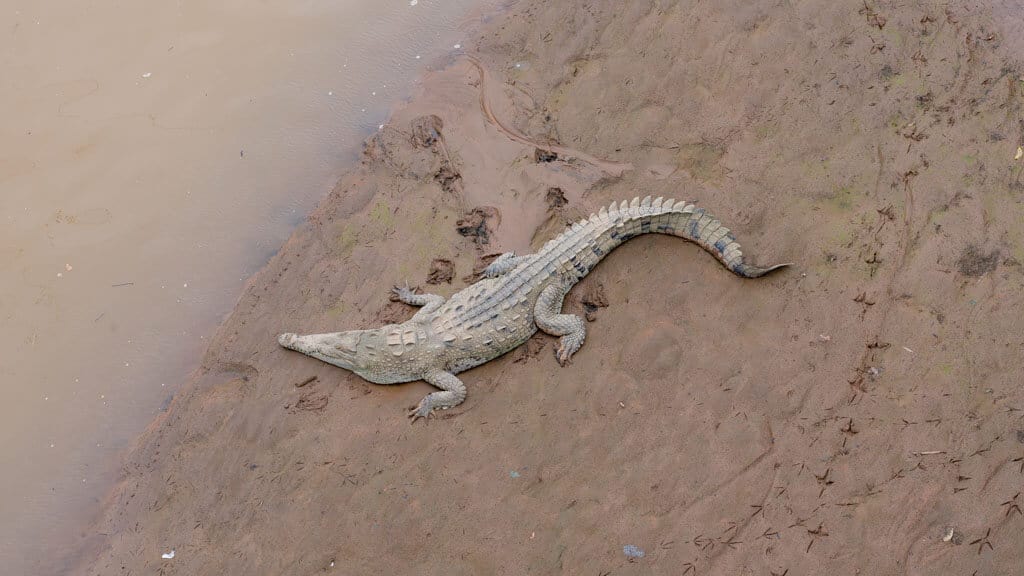
3. Hit the beaches
If there’s one thing that Manuel Antonio is known for outside the national park, it’s beaches!
This area is home to stunning stretches of sand, hidden coves, jungle-clad coastline and sparkling blue waters. There are a ton of beaches both in and outside of the park that are up there as some of the best in Costa Rica.
You’ll definitely visit a handful of the best Manuel Antonio beaches when you visit the national park, but we would also recommend exploring some of the other beaches around town.
We have a post dedicated to the 7 top Manuel Antonio beaches, with more information about getting to each of the beaches, which is best for what activities, the amenities available and more.
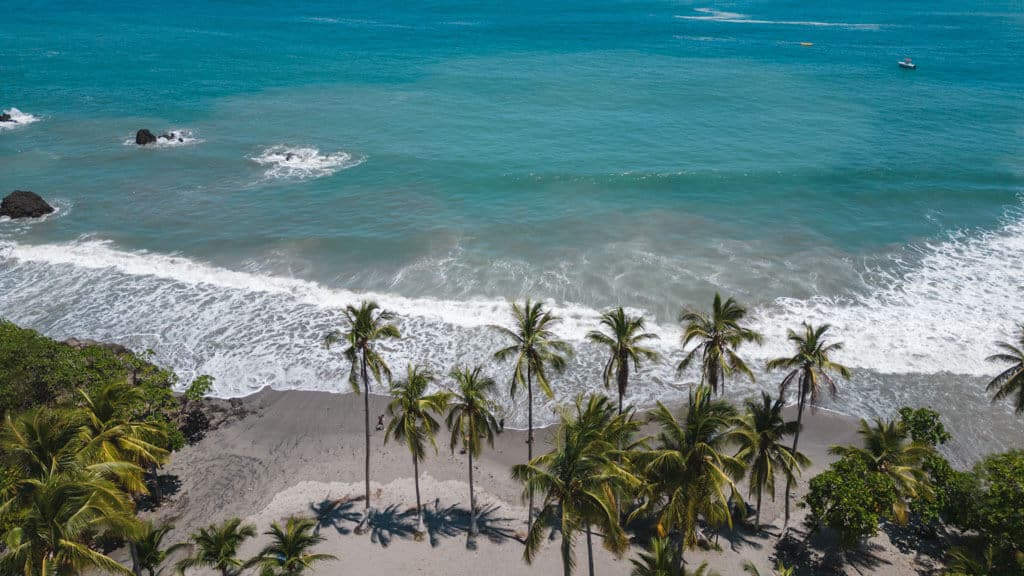
For a sneak peek, here are some of the unmissable beaches in Manuel Antonio:
- Playa Manuel Antonio – the BEST beach in Manuel Antonio in my humble opinion. Calm waters, powdery white sand, jungle lining the shore and wildlife all over. This one is inside the park, and it can get busy, but it’s so worth it!
- Playa Espadilla Sur – the other main beach inside the national park, this huge crescent-shaped bay is rarely busy. The waters are a little rougher here, but there are plenty of shaded spots on the sand to relax.
- Playa Espadilla Norte – an extension of Playa Espadilla Sur that is outside the park’s boundaries. This is the main beach in Manuel Antonio, and is full of activity! You can rent loungers, vendors sell coconuts and drinks, and you can go surfing, parasailing or jet skiing here.
- Playa Biesanz – this calm bay is a secluded paradise. Take a short walk down a jungle path, keeping your eyes peeled for howler monkeys and sloths, before reaching a gorgeous beach with calm waters perfect for swimming.
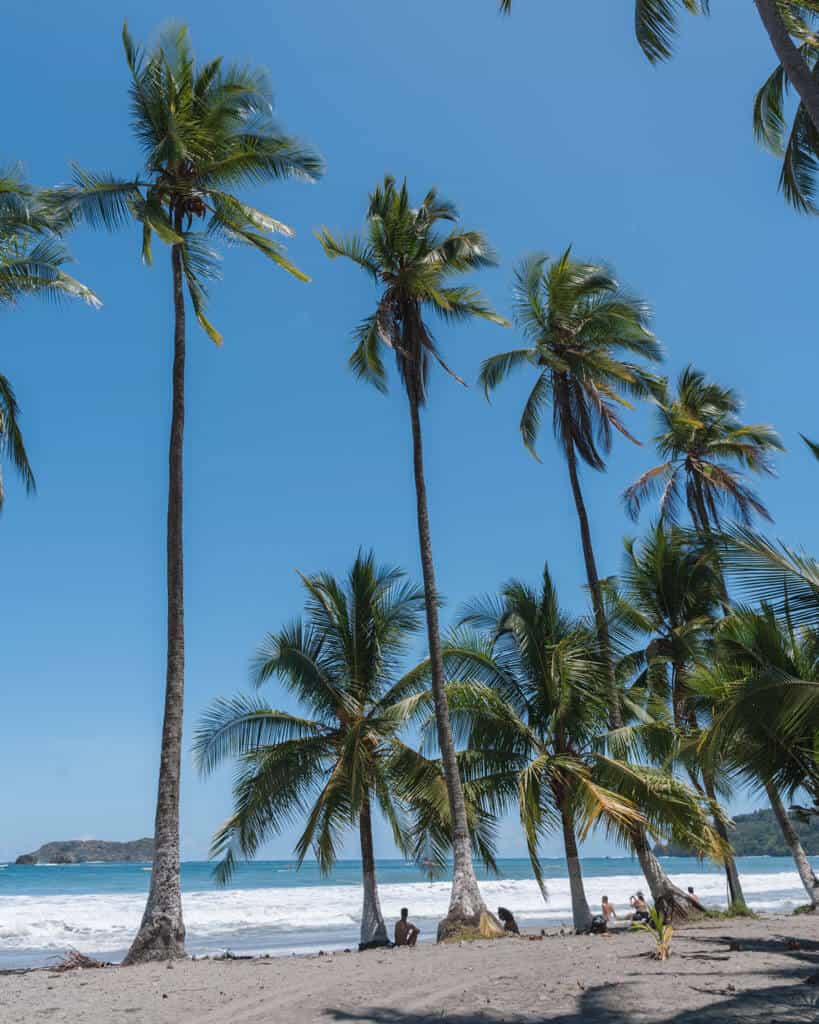
4. Eat in a plane at El Avion
One of the most unique things to do in Manuel Antonio is to have a meal inside an old plane!
El Avion is the onsite restaurant at Hotel Costa Verde, an eco-friendly resort with some very interesting rooms, including another old plane!
Perched a few hundred metres above the ocean in the jungle, El Avion has some of the most spectacular views in all of Manuel Antonio. It’s best visited at sunset, to enjoy a panoramic vista of the sun setting over the horizon, but it’s gorgeous at any time of the day.
The menu is pretty pricey if you’re on a budget as we were, but you can just pop in for a sunset drink, or consider it your one splurge meal. They serve all kinds of Costa Rican and international cuisine, with a focus on seafood.
5. Try some delicious and affordable Costa Rican cuisine
While we’re on the topic of food… So many people think of Manuel Antonio as luxury hotels and fine dining, not a place for budget travellers in Costa Rica. This is true, there are a lot of fancy, high-end places where everything is charged in USD with so many taxes added on.
But there are also some great local restaurants with delicious food at an affordable price.
Here are some of our faves:
- Restaurante Cerdo Feliz – this was our favourite soda in Manuel Antonio! You’d probably want a car to get here, as it is in the hills behind town, but the views are spectacular. They’ve got our two fave local options – casados and fried rice – and both were delicious and cheap.
- Soda El Angel – in a more central area of Manuel Antonio, this was one of the cheapest sodas we visited in Costa Rica with 3,000 Colon casados. Food was great and the fruit smoothies were yummy.
- Food Truck “En Todas” – a really unique food truck nestled just behind Playa Espadilla Norte. It’s not quite as cheap as the other options, but they dish up some fresh and delicious seafood, tacos and burritos, with daily happy hour on cocktails.
- Santa Plancha – the cheapest burgers we’ve ever had at 2,400 Colones (~$4 USD)! Don’t be looking forward to a stuffed, juicy gourmet burger. But if you’re on a budget, this was a great locally-owned spot!
- Falafel Bar – I have to sneak Falafel Bar onto this list, it is a Manuel Antonio institution. Probably not locally owned, and not dirt cheap, the beauty of this place is their self-serve salad bar, so you can really load up your plate with extra goodies for no extra price! Their pitas are great, and it’s really good value for money.

6. Catch an incredible sunset
Given the town of Manuel Antonio is set up on the cliffside overlooking the Pacific Ocean, it turns on some pretty incredible sunsets!
However, it’s not easy to work out where to actually see the sun going down. The best time to see the sunset in Manuel Antonio is during the dry season, as the sun moves throughout the year and it is often concealed by a rocky point in the wet season.
We read a few blogs that mentioned Playa Biesanz as the best spot to watch the sunset, but I can confirm there was absolutely no view of the sun going down in May. And I find it hard to believe it would move that much throughout the year. So, avoid Playa Biesanz for sunset, but please do tell me otherwise if you do see the big flaming ball go down from there!
The best places to see the sunset in Manuel Antonio are:
- Playa Espadilla Norte – for most of the year you can see the actual sun go down from the beach. In the wet season when the sun has moved a bit, you still get a pretty close view and will see the sky glowing up.
- Pull-out point on the side of the road – the best place we discovered to watch the sunset was actually a random pull-out point on Route 618. There was a clearing with no hotels, no restaurants and a safe gravel area to park. Maybe not the best ambience, but the best views for sure! From memory, it was located around here.
- From a bar or restaurant – there are a number of fancy places elevated on the hillside that have great sunset views. Most establishments on the ocean side of Route 618 should have a view, but some recommended options are El Avion, Ronny’s Place and Agua Azul.
- On a catamaran – for the best, uninterrupted sunset views over the water, jump on a catamaran tour! This tour has free-flowing drinks included too.
- In Quepos – Quepos has a better year-round view of the sunset. Most places along the waterfront malecon have a good view, otherwise, the Pez Vela Marina is a good vantage point with lots of bars and restaurants.

7. Learn to surf
Manuel Antonio isn’t usually mentioned as one of the top surfing destinations in Costa Rica. If you’re an advanced surfer, you’re better off heading south to Dominical where the waves are bigger.
But if you’re a beginner, Manuel Antonio is a fantastic place to learn and improve your surfing. Playa Espadilla Norte and Playa Playitas are the best beaches for surfing, with Espadilla being the better choice for beginners, and Playitas for those with a little bit of experience.
The season and tides can affect the swell, but usually, it is small-medium waves. Even if you’ve got a bit of practice under your belt, we would highly recommend taking at least one lesson, so you’re familiar with the break. After that, you can easily rent boards on the beach.
It is possible to organise lessons on the beach too, but doing it this way you never really know if you’re getting a good instructor. It’s best to do your research online in advance or book a tour with other reviews. This surf school is highly rated and offers transport from your accommodation and a drink and snack after the class too.
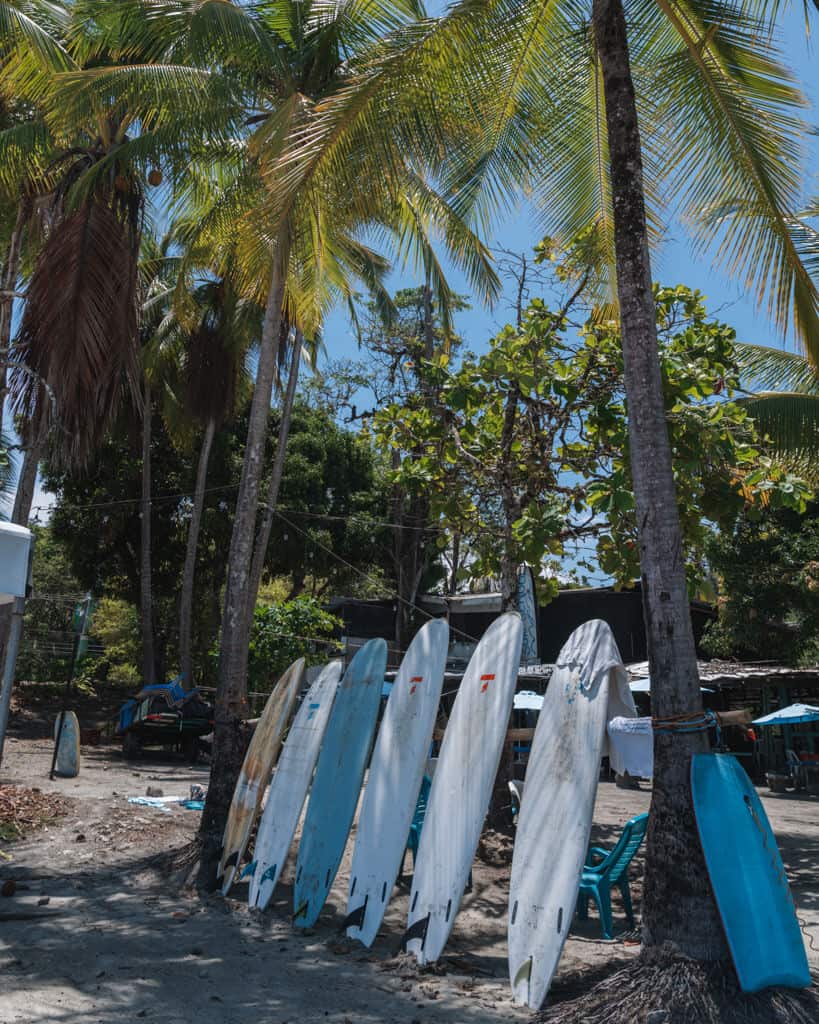
8. Check out the neighbouring town of Quepos
The neighbouring town of Quepos is the larger of the two towns. It has a much more local feel, with a busy bus station, crowded markets and authentic Costa Rican restaurants.
It’s worth spending a few hours wandering around town. There is a short waterfront malecon (promenade), that you can stroll along with some amazing ocean views. We recommend heading further on to Parque Nahomi, the path winds along some stunning bays.
The Pez Vela Marina is definitely worth a visit too. It’s an upscale marina with an open-air mall and some nice restaurants. It has a great vibe and is a wonderful spot to spend an evening watching the sunset.
If you’re in town on a Friday or a Saturday, be sure to check out the Quepos Farmers Market. This is one of the largest markets in the area, and local farmers come from all over to sell fresh produce (with tons of tropical fruits!), dairy, honey, eggs and more.
If you’ve got a car, it’s an easy drive from Manuel Antonio. Otherwise, the local bus runs along Route 618 between Quepos and Manuel Antonio frequently throughout the day.
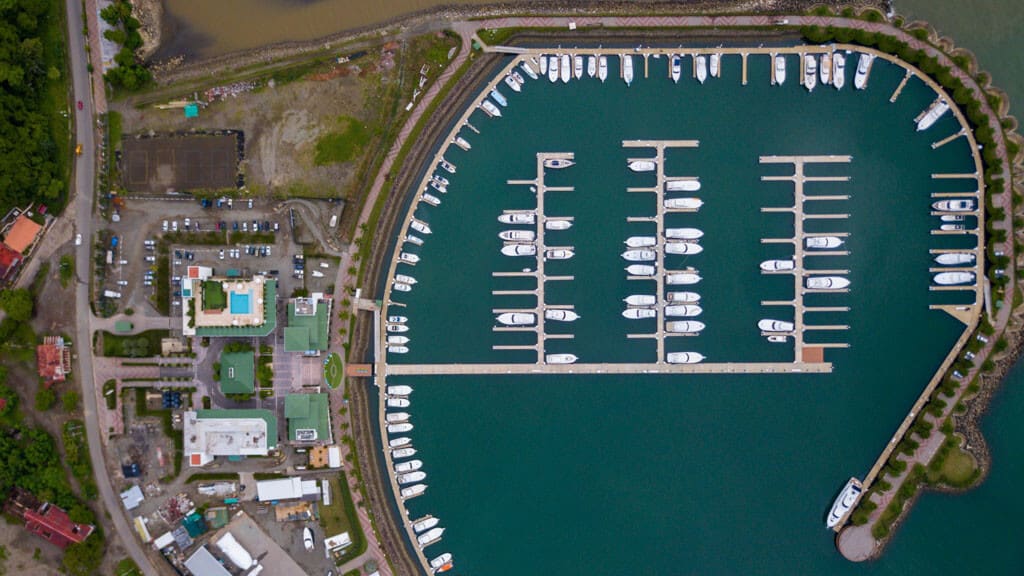
9. Cruise around on a catamaran tour
The coastline of Manuel Antonio is simply stunning. Jungle-clad hills fall into white sand beaches, with secluded coves, rocky capes and offshore islands.
The best way to experience this is from the water on a catamaran tour!
This tour departs from the Marina Pez Vela in Quepos, but it includes pick-up from your accommodation in Manuel Antonio.
Although snorkelling is part of the offering, I will warn you that snorkelling isn’t that great around Manuel Antonio. Strong waves and currents can cause the water to be murky with low visibility, and there isn’t a ton of life to see.
But if you’re just keen to enjoy a day on the water, admiring the views, swimming, sliding down waterslides and enjoying an open bar, taking a catamaran tour is a really fun activity.
If you’re lucky, you’ll spot dolphins swimming alongside the boat. During whale season (December – mid-April and mid-July – November), your captain will also be looking out for any playful humpbacks in the area.
You can choose to take a morning tour, which is best for those with a focus on snorkelling and seeing marine life. Or an afternoon sunset tour, which is a gorgeous way to end the day, and watch the sun setting, which isn’t possible to see from everywhere in Manuel Antonio.
👉🏼 Book your catamaran tour here – choose morning 🐠 or sunset 🌞
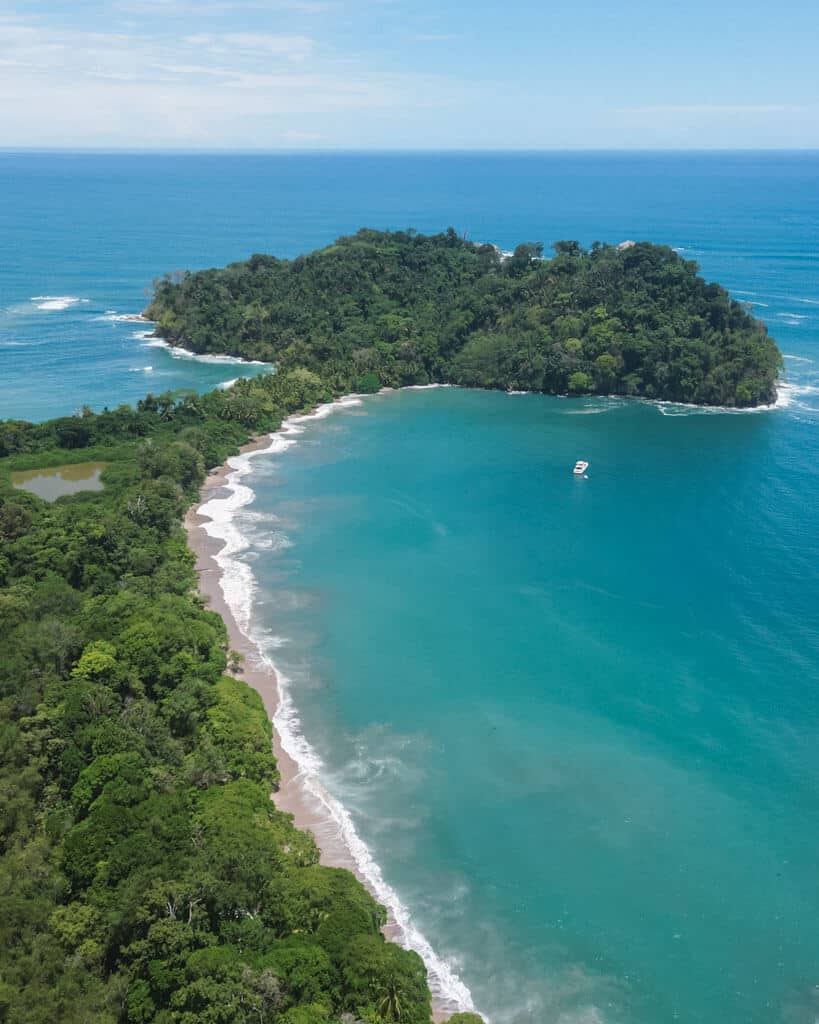
10. Explore Damas Island on a mangrove tour
Mangroves are one of the most important ecosystems in the world. Their carbon absorption and filtering capabilities are astounding, and they provide refuge to a range of wildlife.
Isla Damas (Damas Island) is a small island just north of Quepos, home to a pristine mangrove forest. A series of estuaries and canals wind through the area, and you can choose to explore it via boat or kayak.
A kayak tour will allow you to get up smaller canals, and closer to wildlife. A boat tour is more appropriate for those with limited fitness and mobility, or little children.
With either option, you’ll have an experienced guide pointing out wildlife and teaching you about the mangroves. It’s not uncommon to spot monkeys, sloths, racoons, crocodiles, boa constrictors, iguanas and crabs!
We didn’t do a mangrove tour in Manuel Antonio, but we kayaked through mangroves at Sloth Point in Puerto Viejo and it was so beautiful and relaxing.
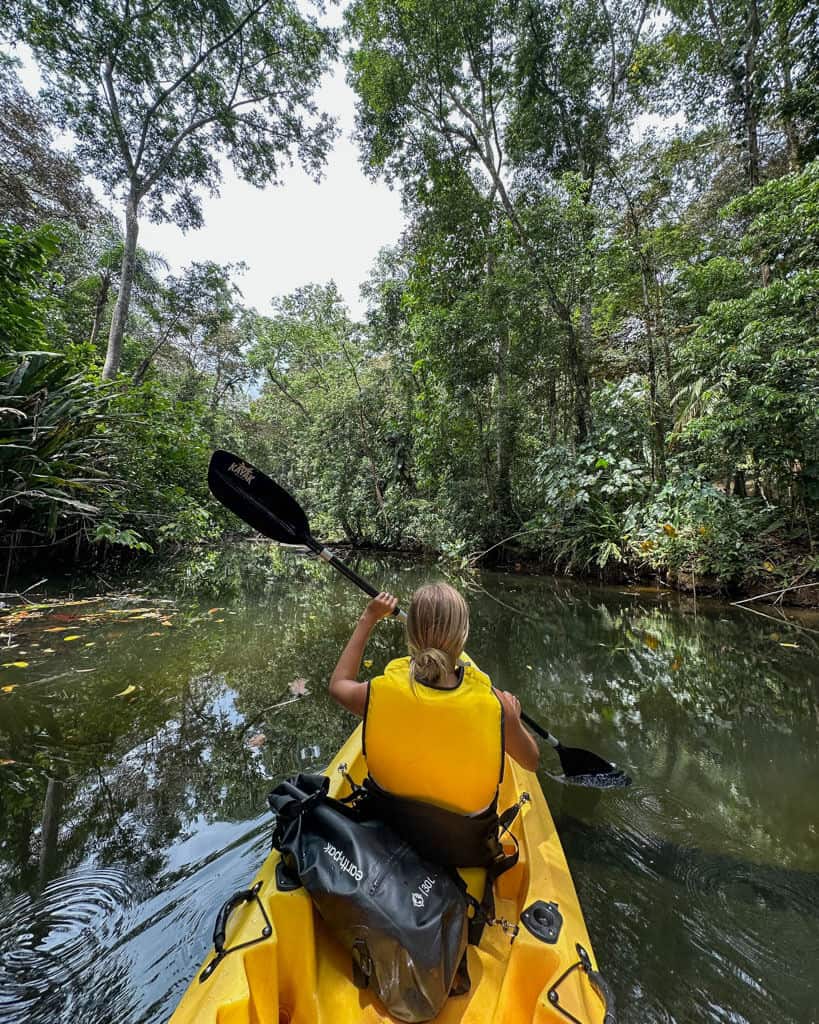
11. Discover the jungle after dark on a night tour
It’s one thing to experience the jungle during the day, but it is a whole other place at night. With a whole range of creepy crawlies and nocturnal critters coming out and about to play, a night tour is one of the best things to do in Manuel Antonio.
After picking you up from your accommodation, a naturalist guide will lead you on a 2-hour walk through the jungle in a private nature reserve just outside of Manuel Antonio.
In the cover of darkness, animals such as bats, frogs, spiders and snakes are more active, and your guide will point out these species that you are unlikely to see during the day.
Dinner is included on-site afterwards, which is a nice touch and means you can get dropped off at your accommodation after the tour and not need to head out again for a meal!
Night tours are possible all over Costa Rica, and it’s something you will probably only do once. If you’re heading south to the Osa Peninsula, I would recommend saving the night tour until then. It’s one of the best Drake Bay tours to do, and given the Osa Peninsula is the most biodiverse area in the country you will see a lot!
If you’re not, Manuel Antonio is still a great choice as there is plenty of wildlife to see in the area.
👉🏼 We recommend this Manuel Antonio Night Tour
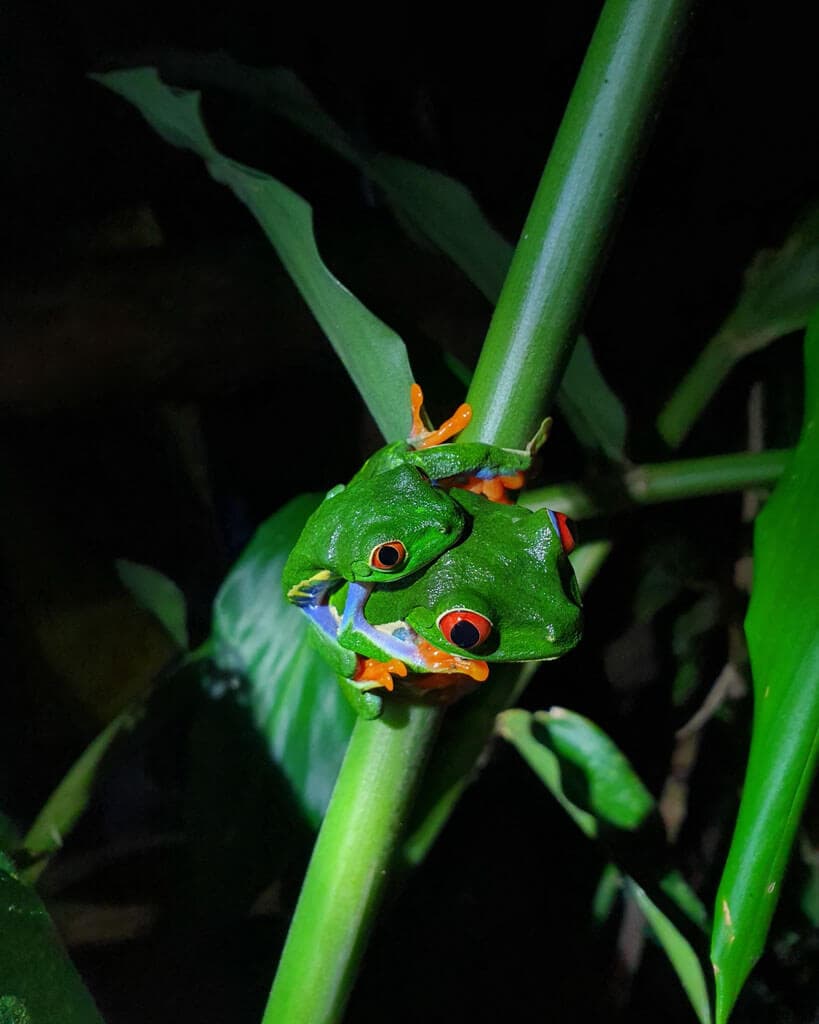
12. Fly across the canopy ziplining
Although Monteverde is the most popular place in Costa Rica to go ziplining (and where we went), there is a canopy tour available in Manuel Antonio. And it’s a pretty impressive one at that!
Hosting Central America’s longest twin zipline, you can race your partner, family or friends across the canopy. This particular line is over 1.3 km / 0.8 mi long! The tour also includes suspension bridges, repelling and 9 other ziplines, totalling over 3.6 km / 2.2 mi of zipping!
The zipline tour is located very close to the national park, and this particular area is super lush and tropical, making for some amazing rainforest views as you fly over the top of the trees.
For the price, transport from your accommodation is included as well as lunch after your tour. I think this is really great value compared to other canopy tours around the country.
13. Support the ethical Kids Saving The Rainforest Wildlife Rescue Centre
If you didn’t see as many animals in Manuel Antonio National Park as you would have liked, we recommend a visit to the Kids Saving The Rainforest Wildlife Rescue Centre.
I’m very sceptical of any captive animal experiences, but the KSTR rescue centre is verified by the Global Federation of Animal Sanctuaries, so you can be sure their work is ethical.
They rescue sick and injured wildlife, rehabilitate and release them back into the wild wherever possible. Unfortunately, some animals are too domesticated to humans, or too injured to be able to survive in the wild, so they have a permanent home at the sanctuary.
There are two options to visit the sanctuary:
- A 1.5-hour guided tour – where you will visit all the animals at the centre and learn more about their species, threats and care needs. A small snack is included and you can use the sanctuary’s pool after the tour.
- A full-day volunteer program – where you will be involved in the day-to-day caring of the animals, such as preparing their food, cleaning their cages and enrichment activities. A full lunch is included, and you can cool down with a dip in the pool.
With either option, you’ll need to drive yourself to KSTR, which is about half an hour from Manuel Antonio. At the time of writing, the centre was closed to all visitors every Monday.
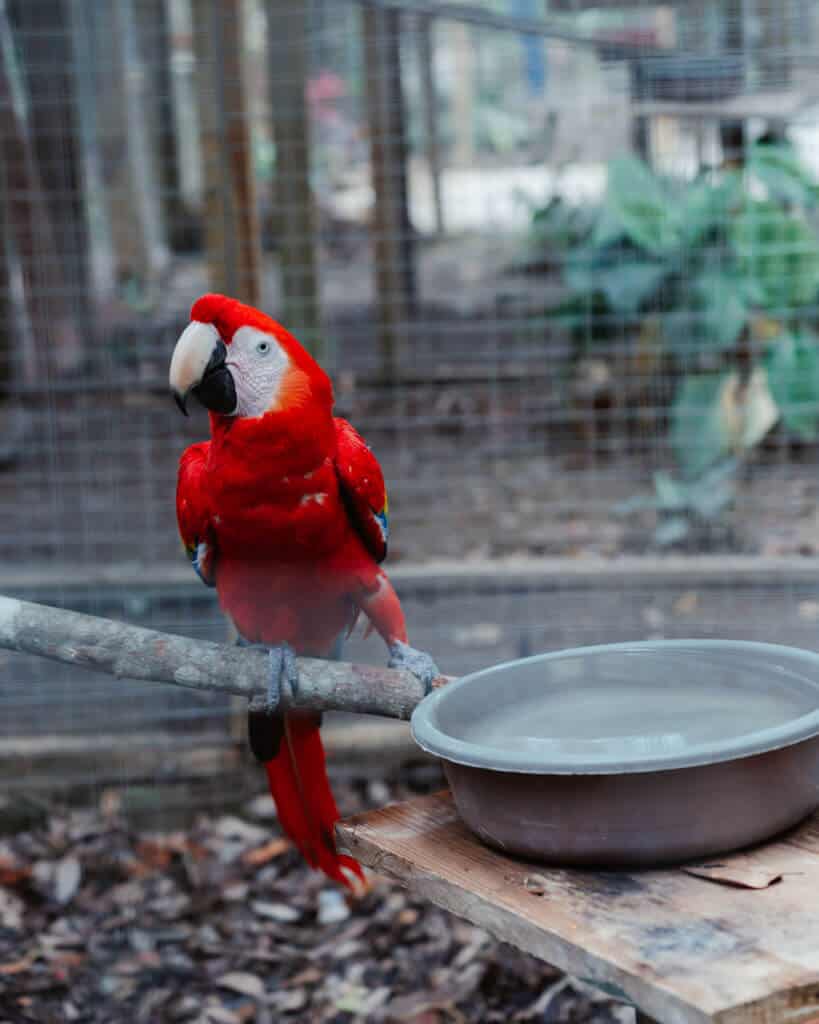
14. Join a coffee and chocolate tour
Costa Rica is a well-known producer of coffee and chocolate. Taking a tour to learn about how these delicious goodies are grown, harvested and produced is a fascinating experience that you should have at least once in the country.
Most of us have coffee (and maybe even chocolate?) every day, so it’s really interesting to see how these products go from plant to bar and bean to cup. There is so much involved in just one cup of coffee, which most of us drink multiple times per day.
You’ll visit a farm, and learn about the entire process of making chocolate and coffee, with plenty of samples at each stage. These crops are so important to the Costa Rican economy and provide a livelihood for many people.
You can take these kinds of tours all over Costa Rica, and you only need to do it once. This tour in Manuel Antonio is a really popular option, so this might be the best place to include a coffee and chocolate tour on your Costa Rica itinerary.
👉🏼 This is the highest rated chocolate and coffee tour in Manuel Antonio
We had already taken a tour like this in Guatemala, so we didn’t experience it again in Costa Rica. We loved the tour though, and highly recommend doing at least one in the region.

15. Ride the rapids white water rafting
White water rafting is another activity that is popular all over Costa Rica and can be done from many different destinations. However, Manuel Antonio is a great place to go rafting, with two rivers very nearby.
Depending on the level of thrills you’re chasing, you can choose between the Savegre River and the Naranjo River.
Let me just say that I am NOT a rafting gal. I don’t mind a bit of adrenaline, but for some reason, white water rafting has never really interested me. So this isn’t first-hand experience, but we saw and read a lot about these options when in Manuel Antonio.
The Rio Savegre is a much calmer option, offering class II – III rapids. This tour is suitable for kids aged 6 and up, and also includes a stop at a secluded waterfall, so it’s not just about the rafting.
For a medium level of thrill, the Rio Naranjo offers class III – IV rapids. This tour is suitable for kids aged 12 and up. While it will definitely get your heart pumping, it’s a mix of thrilling rapids, and some calmer sections of river to soak up the scenery and wildlife.
If you’re an adrenalin junkie, there is a famous section of the Rio Naranjo, ‘El Chorro‘, that offers class IV – V rapids. You need to be 15 years or older to participate, and you probably want some rafting experience (or at least very big balls!). Winding through narrow canyons with steep drops, this is some seriously technical rafting.
- 😀 Rio Savegre – low intensity, class II – III, kids 6+
- 😝 Rio Naranjo – medium intensity, class III – IV, kids 12+
- 🫣 Rio Naranjo (El Chorro) – high intensity, class IV – V, kids 15+
All these tours are run by the highly rated and professional Amigos del Rio, who specialise in white water rafting tours. They all include transport from Manuel Antonio, snacks and lunch.
16. Visit the Rainmaker Conservation Park
Approximately 40 minutes from Manuel Antonio is the Rainmaker Conservation Park. This privately owned nature reserve is home to a number of jungle trails, waterfalls, canopy bridges and plenty of wildlife!
If you’ve done the Manuel Antonio National Park and are still eager to see more wildlife and immerse yourself in the rainforest, a visit to Rainmaker will satisfy the cravings.
The suspension canopy bridges are similar to those on offer at Mistico Hanging Bridges in La Fortuna. If you’ve done those, you may not feel the need to visit Rainmaker. But if La Fortuna isn’t on your itinerary, this is a great way to experience the iconic Costa Rican hanging bridges in Manuel Antonio.
If you’ve got your own rental car, you can drive yourself to the park (no 4×4 required). There you’ll have the option of a self-guided visit or joining a tour of the park.
At the time of writing, the self-guided visit is $20 USD + tax, and you can lead yourself around the park between the hours of 7:30 am – 6:00 pm. No reservation is needed. The guided tour option is $65 USD + tax and will give you the expertise of a local guide pointing out wildlife along the trails and teaching you more about the flora and fauna of the park.
If you don’t have a car, we would recommend taking this all-inclusive tour. It includes transport from your accommodation in Manuel Antonio, a guided tour of the park and lunch on-site for $85 USD.
We didn’t go to Rainmaker, as we had already visited the Mistico Hanging Bridges in La Fortuna.

Day trips from Manuel Antonio
The below recommendations are for day trips that are at least 1 hour or more away from Manuel Antonio.
Most of these day trips are concentrated south of Manuel Antonio around Dominical and Uvita. As I mentioned, if you’re already planning to stay in these places, these recommendations probably won’t be relevant as you can do all these activities from their respective destination.
👉🏼 Got some more time on your Costa Rica itinerary? Head even further south to Drake Bay, a rugged and remote beach town and the gateway to Corcovado National Park
17. Take a day trip to Nauyaca Waterfalls
The Nauyaca Waterfalls are some of the most beautiful waterfalls in all of Costa Rica. Like something out of a jungle fairy tale, the most picture-perfect waterfall you have ever seen drops over a rocky cliff in a curtain of water into a huge pool below.
Visiting the waterfalls is actually quite complicated as there are two competing businesses, both with an entrance to the waterfall – Don Lulo’s Nauyaca Waterfalls and the Nauyaca Waterfall Nature Park. From there, both have a variety of options for actually reaching the waterfalls, like hiking, horse riding or 4×4 transport.
We wrote a complete guide to visiting Nauyaca Waterfalls, with an in-depth breakdown of the two entrances, and all the different ways to reach the falls.
If you’ve got your own car, it’s an easy 1-1.5 hour drive, depending on the entrance you choose.
Otherwise, we would recommend joining a tour from Manuel Antonio, which will take care of your transport and the decisions around which entrance you use. Here are our top recommendations:
- Nauyaca Half-Day Waterfall Tour from Quepos/Manuel Antonio – this is the highest-rated tour of the waterfalls. It takes you to the Nauyaca Waterfall Nature Park, where you will hike down to the falls, and take the shuttle back. The tour includes transport from any accommodation in Manuel Antonio or Quepos, entrance to the falls, a guide to lead you on the hike, and lunch on the way back.
- Nauyaca Waterfalls Hiking or 4×4 Ride Tour from Quepos/Manuel Antonio – this tour takes you to the waterfalls via the Don Lulo’s entrance. You have the option to hike or take the 4×4 transport to the falls. You can also choose to upgrade to the horse riding option for an extra cost. It picks you up from your accommodation in Manuel Antonio or Quepos and includes lunch.
- All-Inclusive Full-Day Nauyaca Waterfall and Beach Town Tour from Quepos/Manuel Antonio – this tour is different from the other offerings as it includes stops at some other places in the Dominical area. In addition to visiting the Nauyaca Waterfall Nature Park, you’ll stop at Playa Linda, a deserted beach, another hidden local waterfall, and in the town of Dominical, to grab an ice cream or a coffee, and browse the markets. You get lunch included at a local soda too. Considering you’ve made the trip south, this tour is a great option and allows you to experience more of the area.

18. See the unique whale tail at the Marino Ballena National Park in Uvita
Just an hour south of Manuel Antonio lies the town of Uvita. It’s possible that you’ve got a few days in Uvita on your itinerary, we did.
If you’re not planning to stay in Uvita, it is very worth visiting this town for a day trip from Manuel Antonio! There are a number of great things to do in Uvita, but one of the most iconic and unusual is to see the Uvita Whale Tail.

At low tide, a rocky peninsula appears just off the coast of Playa Uvita, shaped exactly like the tail of a whale. You can walk hundreds of metres into the ocean along a sandbank, with waves breaking on either side of you.
Playa Uvita, and a string of neighbouring beaches, are part of the Marino Ballena National Park. This means you need to pay an entrance fee of $6 USD to access the beach.
Because the beach is protected by the national park, there is no development. It feels raw and wild, lined with thousands of palm trees and backed by jungle-covered mountains. It was one of the most beautiful beaches we saw in Costa Rica.


19. Go whale watching in Uvita
Uvita is famous for whales in more ways than one. In addition to the strange whale tail-shaped peninsula, the area is actually the best whale watching spot in Costa Rica! It is possible to see whales around Manuel Antonio, but if you’re serious about getting an up-close encounter, Uvita is the place.
Each year two separate migrations of humpback whales pass through the area. One of the only places in the world that hosts two annual migration events, you can see whales off the coast of Uvita for up to 10 months a year!
Whales from northern areas like Alaska migrate south during the northern hemisphere winter, from December – mid-April. Whales from Antarctica in the south migrate north during the southern hemisphere winter, from mid-July – November.
The whales don’t come near to the shore, so the only way to see them is via a boat tour. This tour is highly rated and includes the Marino Ballena National Park entry fee. You will spend approximately 3 hours looking for whales, as well as other marine life like dolphins and turtles.
Tours depart from Uvita, so you’ll need to get yourself there. A rental car is best, but you can also take a bus from Quepos.
It’s worth combining your whale watching tour with a visit to the whale tail. Your national park entry fee is valid for the full day, so you can spend the afternoon on Playa Uvita checking out the whale tail before heading back to Manuel Antonio.
👉🏼 Check out our recommended Uvita whale watching tour

20. Explore the hippy surf town of Dominical
If your Costa Rica itinerary includes time in Dominical or Uvita, there’s no need to do this from Manuel Antonio. But if you’re not heading any further south, Dominical is a really cool hippy surf town that is worth checking out!
If you’ve got your own rental car, you could combine this with Nauyaca Waterfalls as Dominical is very close to the falls.
Just a handful of dusty streets centred around the expansive Playa Dominical, it has a totally different feel to Manuel Antonio. It’s far less popular, giving it a more laid-back vibe. But despite its size, there are some great things to do in Dominical.
Here are some things you can’t miss:
- Markets – Dominical is famous for its beachfront markets. All day every day there are an assortment of stalls lined up behind the beach, selling all kinds of souvenirs and trinkets. Handmade jewellery, clothes, Costa Rica branded goodies, there is a ton to browse.
- Dominicalito – just outside of Dominical is the smaller and calmer Playa Dominicalito. This beach was one of our favourites in the area, and it is not as busy as some of the Manuel Antonio beaches. The shore is lined with palm trees, and the water is calm enough for swimmers and beginner surfers.
- Cascada Poza Azul – just behind Playa Dominicalito is this local waterfall. Rarely busy, completely free to enter and a gorgeous jungle vibe make this a worthy stop! The fall itself is small, but there is a large pool to swim in, and a fun rope swing if you’re up for it.


Where to stay in Manuel Antonio
There are some incredible places to stay around Manuel Antonio.
Although many travellers base themselves in nearby Quepos, which is a larger town with more budget-friendly accommodations, we recommend staying in Manuel Antonio. It has a much more natural, jungle vibe, and you’ll be much closer to all these gorgeous beaches and the national park.
It’s hard to narrow down all the great hotels in Manuel Antonio, but here are some of our favourites.
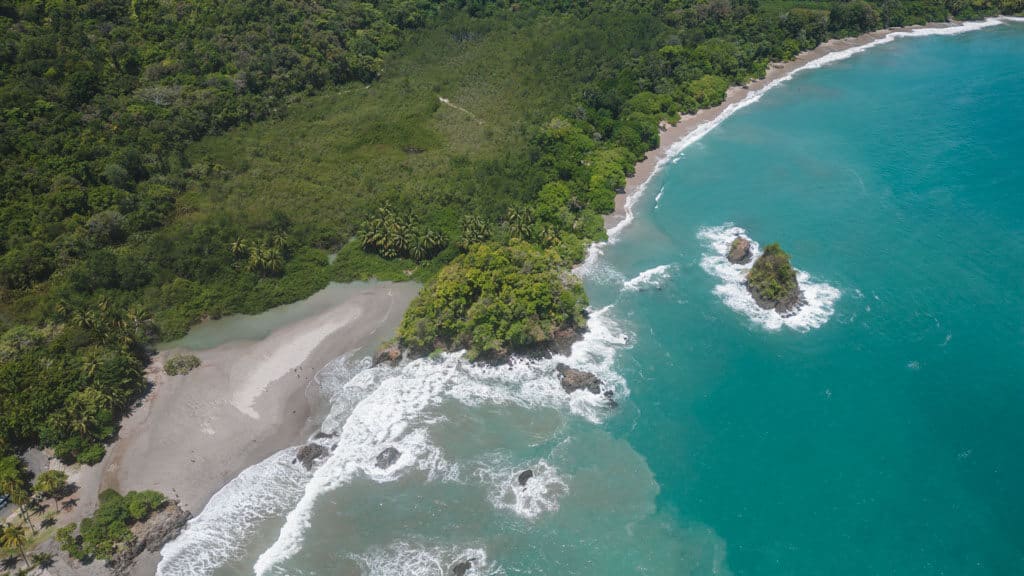
Budget options
- 💰 Teva Jungle Hotel and Hostel – an eco-style hotel and hostel nestled into the jungle near the centre of town. The property has a huge nature reserve attached with miles of trails to explore. There are dorms and very lovely private rooms, an on-site pool, a communal kitchen and a restaurant.
- $10 USD + per night check prices and browse photos here
- 💰 Hostel Plinio – at the Quepos end of town, this highly rated option is loved by travellers. A true jungle setting with a large swimming pool, daily breakfast and a communal kitchen. There are dorms and private rooms.
- $15 USD + per night check prices and browse photos here
- 💰 Selina Manuel Antonio – a great budget option, the Selina here is just as good as all their other properties around Costa Rica. Privates and dorms are available, and the property is huge and blends into the jungle. There’s a pool and all the usual Selina amenities on-site.
- $20 USD + per night check prices and browse photos here
Mid-range options
- 💰💰 Peace of Paradise – well equipped, well located with gorgeous jungle views and a ton of wildlife around. What’s not to love? If you want the ability to cook your own meals, this is a fantastic option. Located within easy walking distance of the shops, restaurants and cafes of Manuel Antonio town, the bus stop is close by to reach the national park and beaches. Superbly rated by all previous guests.
- $100 USD + per night check prices and browse photos here
- 💰💰 La Posada Jungle Hotel – fantastic location near Playa Espadilla Norte and the park entrance. A simple but well-maintained hotel with jungle vibes, and tons of wildlife! There is a swimming pool, and the rooms are spacious and well-equipped.
- $100 USD + per night check prices and browse photos here
- 💰💰 Milennium Manuel Antonio – another great option right near the entrance to the national park and Playa Espadilla Norte. The rooms get a lot more modern and nicer as you go up the categories, but all are quite large and spacious. There is a nice swimming pool, with breakfast included.
- $100 USD + per night check prices and browse photos here
Boutique options
- 💰💰💰 Shana By The Beach – there are countless gorgeous boutique hotels and resorts in Manuel Antonio but this is a goodie. Situated right next to Playa Biesanz, nestled into the rainforest, you’ll spot monkeys, toucans and other animals throughout your stay. Gorgeous ocean views, multiple pools and daily breakfast included.
- $175 USD + per night check prices and browse photos here
- 💰💰💰 Hotel Playa Espadilla & Gardens – a gorgeous resort-style hotel with large and well-equipped rooms, tropical grounds and a swimming pool. In a perfect location to walk to the park, as well as to Playa Espadilla Norte. Very well rated.
- $180 USD + per night check prices and browse photos here
- 💰💰💰 La Vela Boutique Hotel – the pick of the bunch near the park and Espadilla Norte, this stunning hotel is sleek and modern. The grounds ooze tropical vibes and there is a large swimming pool. The suites are worth splurging for, with a spacious covered balcony with jungle views. Daily breakfast included.
- $200 USD + per night check prices and browse photos here
⛺️ If you’re camping in Costa Rica as we were, Manuel Antonio is a really hard place to camp. We couldn’t find any good paid campgrounds, and the only verified free camp spots on iOverlander were in Quepos. Our friends checked a couple of them out, but they didn’t feel comfortable staying there, as there were a couple of questionable characters hanging around and the vibe wasn’t good.
We took the opportunity to have a couple of nights out of the car, to do some laundry and have a hot shower! If you have a good experience at a campground in Manuel Antonio or Quepos, please let me know in the comments.
How to get to Manuel Antonio
- 🚙 By car – like everywhere in Costa Rica, getting to Manuel Antonio is best done with your own rental car. It will give you a lot more freedom when choosing somewhere to stay, and get around the area. It is approximately 3 hours drive from San Jose.
- 🚌 By bus – if your budget doesn’t allow a car, you can get to Manuel Antonio via bus. There are multiple daily departures from San Jose to Quepos with Tracopa. They have their own terminal in San Jose, located here. From Quepos, you can connect with the local bus that runs between there and Manuel Antonio.
- 🚐 By tourist shuttle – Otherwise, you can opt for a tourist shuttle. More expensive than the bus, but far more reliable and stress-free, a shuttle will pick you up from your accommodation and drop you off in Manuel Antonio. There are direct shuttles from many different destinations around Costa Rica, like San Jose, Monteverde, La Fortuna, Santa Teresa or Montezuma.
How to get around in Manuel Antonio
- 👣 On foot – walking isn’t really the most ideal way to get around Manuel Antonio, as Route 618 is narrow, steep and winding. It’s not always safe to walk. But depending on where you’re staying, you should be able to walk a short distance to the beach or restaurants.
- 🚙 With your own car – ideally you’ve come with a rental car, giving you complete freedom to explore Manuel Antonio and its surrounds. This is especially useful if you’re using Manuel Antonio as a base to do day trips to other destinations on the Pacific Coast.
- 🚌 On the bus – the bus between Manuel Antonio and Quepos is a great way to get around, and it’s affordable and efficient. The bus runs up and down Route 618 between Quepos and the national park all day, every 30 minutes from around 5:30 am. Most attractions in the immediate area can be reached from a bus stop, with a bit of walking.
- 🚐 By tour – so many of the best things to do in Manuel Antonio require a tour, and they generally all include transport to and from your accommodation. It definitely makes it possible to live without a rental car, and instead spend the money on tours.
- 🚕 By taxi – there are also taxis plying around the town. They aren’t particularly cheap, but they can get you further than the bus if required.
I hope this list of things to do in Manuel Antonio has helped inspire you and plan your time in this jungle beach wildlife haven! Be sure to set aside at least a few days to do more than just the national park.
More Manuel Antonio guides











